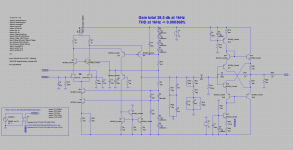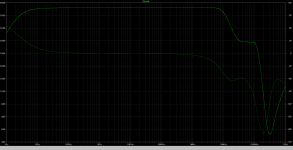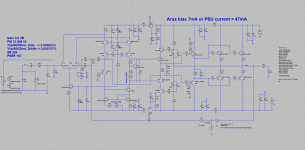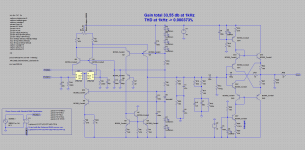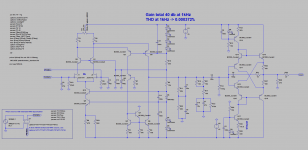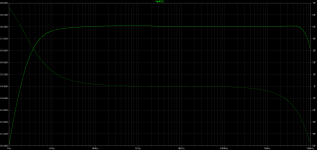I don't have phono player but I like learn everything in audio electronic. I'm interested after reading balanced moving magnet (MM) pre-amplifier at Bob Cordell's website. Later I also read MM pre-amplifier by Scott Wurcer. They use JFET input in folded cascode topology. Bob Cordell's version: the equalization done in 2 ways. First, 75uS passive and other is active using op-amp. Scott Wurcer's version all equalization is passive. I choose all equalization passive because the signal level is very low. And I used only 2SK170 because my friend still have several pieces of this jfet and another friend have phono player, so I can test it someday.
I biased 2SK170 at 3,6mA because at this current the input voltage noise is minimum. I use diamond buffer to isolated the passive equalization. Gain about 38,5 dB at 1kHz and distortion is relative low because signal level is small.
Any suggestion are welcome.
I biased 2SK170 at 3,6mA because at this current the input voltage noise is minimum. I use diamond buffer to isolated the passive equalization. Gain about 38,5 dB at 1kHz and distortion is relative low because signal level is small.
Any suggestion are welcome.
Attachments
The value of R9, R10 will depend upon the inductance of the cartridge....if you are following Cordell's "Vinyl-Trak" ideas.
C8, C9, C10, C11 should be 1%, Polystyrene type desirable.
All 100nF capacitor is ceramic X7R or MKP.
C1 and C2 are silver mica or ceramic COG/NP0.
C12 is Polystyrene or MKP.
All resistors are 1%.
2 transistors which mount face to face can thermally couple.
All 100nF capacitor is ceramic X7R or MKP.
C1 and C2 are silver mica or ceramic COG/NP0.
C12 is Polystyrene or MKP.
All resistors are 1%.
2 transistors which mount face to face can thermally couple.
You can look Scott Wurcer's version, which is balanced output.Since there is balanced input, any possibility for balanced output?
I sim folded cascode pre-amplifier that can use after MM pre-amplifier or line pre-amplifier.
For input, i use 2SK117 which is easier to get than 2SK170. Compensation using two pole variant.
R44 to set output transistor about 7.29mA each or about 47mA from power supply. So it will work in class A for load impedance minimum 500 Ohm.
C15 can be shorted because DC offset can adjust using R61, but I'm not sure if JFET need to be matched or not.
Gain about 9.6 dB, low THD, high slew rate, high PSRR.
For input, i use 2SK117 which is easier to get than 2SK170. Compensation using two pole variant.
R44 to set output transistor about 7.29mA each or about 47mA from power supply. So it will work in class A for load impedance minimum 500 Ohm.
C15 can be shorted because DC offset can adjust using R61, but I'm not sure if JFET need to be matched or not.
Gain about 9.6 dB, low THD, high slew rate, high PSRR.
Attachments
From me as well, nice circuit Bimo.
Suggestions... if I may, have a look at TI's new tightly matched ultra-low noise dual N-ch JFET (JFE2140) which is readily available from safe sources such as Digikey, Mouser and also directly from TI for a pretty attractive price bit under $5 each, TI has an even better price currently for ~$3.30.
https://www.ti.com/product/JFE2140/part-details/JFE2140DR
https://www.digikey.com/en/products/detail/JFE2140DR/296-JFE2140DRCT-ND/15666954
https://eu.mouser.com/ProductDetail/Texas-Instruments/JFE2140DR?qs=A6eO%2BMLsxmQVeRIGZCabaw==
Another dual JFET is LSK389 from Linear Systems, Digikey is nowadays distrubutor for LS, but it costs more than double.
https://linearsystems.com/product-spotlight.html
https://www.digikey.com/en/products/filter/transistors-jfets/288?s=N4IgTCBcDaIDIGUDSBmAHAThAXQL5A
Suggestions... if I may, have a look at TI's new tightly matched ultra-low noise dual N-ch JFET (JFE2140) which is readily available from safe sources such as Digikey, Mouser and also directly from TI for a pretty attractive price bit under $5 each, TI has an even better price currently for ~$3.30.
https://www.ti.com/product/JFE2140/part-details/JFE2140DR
https://www.digikey.com/en/products/detail/JFE2140DR/296-JFE2140DRCT-ND/15666954
https://eu.mouser.com/ProductDetail/Texas-Instruments/JFE2140DR?qs=A6eO%2BMLsxmQVeRIGZCabaw==
Another dual JFET is LSK389 from Linear Systems, Digikey is nowadays distrubutor for LS, but it costs more than double.
https://linearsystems.com/product-spotlight.html
https://www.digikey.com/en/products/filter/transistors-jfets/288?s=N4IgTCBcDaIDIGUDSBmAHAThAXQL5A
Thank you.Suggestions... if I may, have a look at TI's new tightly matched ultra-low noise dual N-ch JFET (JFE2140) which is readily available from safe sources such as Digikey, Mouser and also directly from TI for a pretty attractive price bit under $5 each, TI has an even better price currently for ~$3.30.
For other JFETs, may be need to adjust drain current to achieve lowest input voltage noise. In simulation, you need change the value of R8 and R23.
This is for 40 dB gain.So why not increase gain, 40dB is the usual gain for a MM pre.
Hans
Attachments
Without source degeneration, it's better to match. Unbalance of J1/2 will unbalance Q3/4 and Q4 has a dc load of ~36kΩ. Less then 0.5 mA difference there will freeze that output to a rail.if JFET need to be matched or not
Lower band phase shift occurs from 100Hz downwards. It's not from C4/R14 (2.5Hz). Or is the input signal an inverse riaa-sweep of some kind?
What signal level above 2 kHz upwards is at the Q4/6 collector node?
It seems like the slightest mismatch between C3 and C2 will reduce mid to high frequency common mode rejection pretty drastically. Are these caps required? What happens if you leave them out?
This is the RIAA-reverse transfer function: Laplace=n*(1+T1*s)*(1+T3*s)/(1+T2*s)Lower band phase shift occurs from 100Hz downwards. It's not from C4/R14 (2.5Hz). Or is the input signal an inverse riaa-sweep of some kind?
What signal level above 2 kHz upwards is at the Q4/6 collector node?
And the output of frequency response is:
Attachments
- Home
- Source & Line
- Analogue Source
- Another Idea of Balanced Moving Magnet Pre-amplifier
